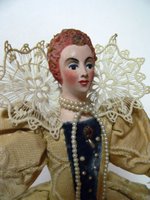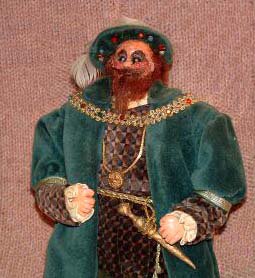
I was very excited last week to be the successful bidder on another of Ann Parker's historical dolls. This time I won the Duke of Wellington, the victor of Waterloo and

Napoleon's conqueror. I think the Ann Parker doll resembles this portrait of the Duke by Sir Thomas Lawrence quite closely.
When I was in London recently, I visited Madame Tussaud's Wax Museum and saw a wax sculpture of the Duke rendered from one of his famous portraits as well. I'm not sure at what age the Duke was reproduced for Madame Tussaud's but his hair was

portrayed as a lighter red frequently seen on natural redheads rather than the darker auburn of his historical portraits. Perhaps artists think the darker red is more elegant looking or something.
Arthur Wellesley, 1st Duke of Wellington, (c. 1 May 1769 – 14 September 1852) was an Irish born British soldier and statesman, widely considered one of the leading military and political figures of the 19th century. Commissioned an Ensign in the British Army, he would rise to prominence in the Napoleonic Wars, eventually reaching the rank of Field Marshal.
Wellington commanded the Allied forces during the Peninsular War, pushing the French Army out of Portugal and Spain and reaching southern France. Victorious and hailed as a hero in England, he was obliged to return to continental Europe to command the Anglo-Allied forces at Waterloo, after which Napoleon was permanently exiled at St. Helena. Wellington was victorious over Napoleon and the French at each of six major battles, confirming his place as one of history's greatest generals and strategists.
Despite oft-cited similarities between Napoleon Bonaparte and Wellington, the strategies and tactics employed by both were diametrically opposed. Perhaps the main reason that Napoleon stands in many history texts above Wellington is that Napoleon offered radical changes in warfare in every respect, whereas Wellington's contribution to warfare lies more in the brilliant use of the old.
Napoleonic tactics were typified by massive conscript armies who advanced in tight columns to rout opposing forces. This was soon adopted by nearly every major participant in the war, with the chief exception of the British as well as the Spanish and Portuguese they trained. In almost every engagement, the tight-packed French columns (in which only the first two ranks and outer edges could fire) would advance, apparently unheeding of casualties. Against the ill-trained and panic-prone armies of the Austrians, Prussians, and the other allied powers, it was spectacularly successful. Against the disciplined and trained British regulars who stood in line in two ranks (thus permitting every man in line to fire), the column was a spectacular failure. Despite the demonstrated helplessness of the French column against the British line, the French commanders in Iberia continued to attack in column. (Indeed, column attacks were used even at the Battle of Waterloo.) Thus, in many instances, a single British battalion would defeat an entire French division.
Wellington is often viewed as a 'defensive general', despite the fact that many of his greatest victories (Assaye, Douro, Salamanca, Vitoria, Toulouse), were all offensive battles. In fact, on the defensive, Wellington made a number of mistakes, most famously at the battle of Fuentes de Oñoro, where a disaster was only averted by his quick thinking and the steadiness of the British and Portuguese troops in retreating under fire.
Strategically, Wellington also appears somewhat anachronistic, with the Peninsular War revolving partly upon the possession and besieging of fortified strongholds. Conventional military wisdom of the era, especially under Napoleon, dictated that the opposing field army was to be eliminated at any price necessary, before disease and wastage could reduce the attacking force to nothing. In pursuit of this aim, desperate measures would be taken, such as winter battles, forced marches, and privation alleviated only by foraging. Wellington's campaigns instead displayed carefully planned offensives, supported by a magnificent supply train, and tempered by subsequent consolidation of gains.
In other strategic areas however, Wellington seemed to forecast the tide of the future. The construction of the fortifications near Torres Vedras, and the subsequent attritional campaign which ensued, seems to typify the manner that warfare would evolve within the following century. He also cooperated closely with the British navy, a necessity for success on the water-bound Iberian Peninsula.
Tactically, Wellington capitalized on the reforms of
Sir John Moore and the
Duke of York by creating large units of independent infantry, often armed with rifles, who fought in both regular and irregular fashion. His relationship with his cavalry arm — as well as his cavalry commanders — was infamously stern and demanding." -
WikipediaI laughed when one of our tour guides pointed out that Wellington had a nude sta

tue of Napoleon produced for his office. When Wellington was asked why the statue was nude, he replied "I needed something to hang my hat on!"
The Duke of Wellington was buried in St. Paul's Cathedral and there I saw his funerary monument when my sister and I attended Palm Sunday services. His sarcophagus lies in the crypt and can be seen on a regular tour of the cathedral when services are not in session.
Anne Parker's dolls are some of the most realistically sculpted portrait dolls I have ever encountered. So far, I am fortunate to have four of her dolls in my collection now. In addition to the Duke of Wellington, I also have Admiral Lord Nelson, Henry VIII, and Anne Boleyn.

















